For our final day of Paper Bag Princess tutorials, we’re going to sew a ‘paper bag’ dress. The paper bag dress we made two days ago is great, but isn’t long lasting. I wanted to sew a fabric dress that could stand up to play, but still looked like Princess Elizabeth’s paper bag dress.

Materials:
- tan fabric (I used an old pair of khaki pants that was ruined in the wash by a pen. You can use stiffer material if you really want to replicate a paper bag.)
- matching thread
- 3/4″ Velcro
- pinking shears
- paper lunch bag
I recommend deconstructing a paper bag at the seams to get an idea of the folds. I have the one I used here and the dimensions. The numbers marked in marker are the dimensions before adding seam allowances.

After adding the seam allowances, you’ll cut panels with the following dimensions:
- two 3 1/4″ X 10″ (these are the two panels that make up the back)
- one 5 1/2″ X 10″ (front)
- two 3 3/4″ X 10″ (sides)
For the following sewing directions, I used 1/4″ seam allowances.
- Sew the long side of 3 1/4″ (back) panel to the long side of the 3 3/4″ (side) panel – right sides together. Repeat for the other two corresponding panels.
- Sew the other long side of the 3 3/4″ (side) panel to the 5 1/2″ (front) panel – right sides together. Repeat for the other side of the 5 1/2″ (front) panel.
- At this point, all of your panels should be connected. Fold and hem the raw, long sides of the 3 1/4″ (back) panels.

Trim across the raw edges on the top and bottom with pinking shears – this helps give it a paper bag look and will keep it from fraying.
Fold 2 1/2″ of fabric down from the top with right sides together. Iron.
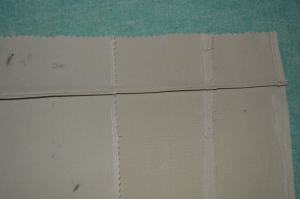
With right sides together, stitch a scant seam across this fold. Fold over so that the wrong isides are together and iron the fold.
Iron all the vertical panels to help make a box shape.
Now we’re going to start folding, ironing, and pinning the base of our paper bag (which is the bottom if you’re packing a lunch, but will be the top of our dress – confusing semantics).
This part can be tricky and using your deconstructed paper bag to visualize the folds can be helpful. Take your time folding the base to make it look like a lunch sack.

Stitch down the diagonal folds coming from the corners. Go slowly and check that your bag is keeping the proper shape as you go. I turned it inside out and stitched with the right side up to keep an eye on the construction.
After that tricky folding, cutting the neck and arm holes is stressful. Cut a small opening and gradually make them larger. You don’t want to make it irreversibly too large -. heartbreaking after all that work. Try it on your doll as you go and adjust the openings accordingly.

I started the arm hole opening with a small cut 1 3/4″ below the shoulder seam with pinking shears.
 I folded the fabric in half and cut it symmetrically.
I folded the fabric in half and cut it symmetrically.
Stay stitch around the opening.

Cut the neck opening at the front of the bag. Stay stitch.
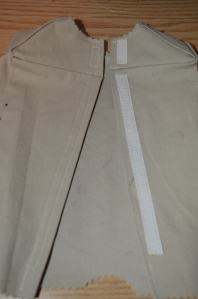
Cut an appropriate length of velcro for the back. I cut the strip in half so that it is not so wide. The back panels overlap, so make sure the panels align to make a symmetrical box before you sew in place. I also put a small strip of velcro on the top.
I didn’t put velcro all the way to the bottom because I wanted to be able to trim the length.

Use pinking shears to trim the bottom of the dress to the length you want. Trace the bottom of a bag onto the front of your dress and cut out that half circle.
Don’t forget to iron the creases in the side of the dress to look like lunch sack folds.
Top with a crown and you’ve done it!
Whew! That ended up being more difficult than I expected, but the dress ended up looking pretty good. Come on, it’s a bag, so it’s only going to look so good. Please tell me my kids will play with it enough to be worth it.
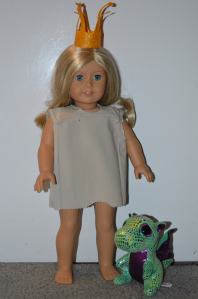
Our next post will be Kiki’s Delivery Service!

 Kiki has a lacy pair of bloomers that peek out from under her dress as she flies her broom.
Kiki has a lacy pair of bloomers that peek out from under her dress as she flies her broom.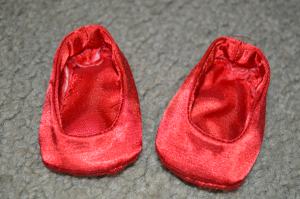 Materials:
Materials:



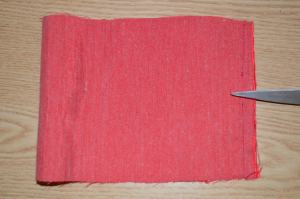


























 I folded the fabric in half and cut it symmetrically.
I folded the fabric in half and cut it symmetrically.







 Glue or sew the two ends. I used a glue gun.
Glue or sew the two ends. I used a glue gun. The painted canvas is stiff enough to hold the prongs up, but flexible enough to be bent down to get the ‘melted’ look of Princess Elizabeth’s crown.
The painted canvas is stiff enough to hold the prongs up, but flexible enough to be bent down to get the ‘melted’ look of Princess Elizabeth’s crown.














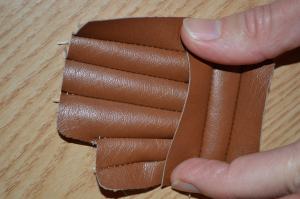





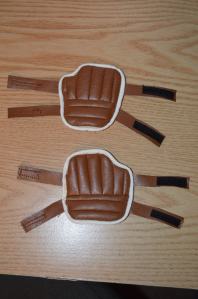
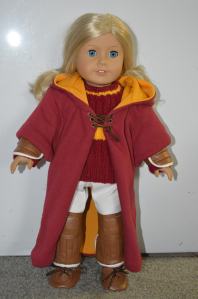

 Starting with the cranberry yarn, I cast on 48 stitches instead of the 37 the pattern states. Rib knit accordions in on itself, so you’ll need more stitches than if you were doing all knit stitches. (I averaged about 8 stitches/inch). Also with the fitted stretch of the rib knit, you don’t need a full 7 1/2″ width per side that the pattern states. The sweater stretches a lot and should fit snugly. I made each side 6″ wide when laying flat and unstretched.
Starting with the cranberry yarn, I cast on 48 stitches instead of the 37 the pattern states. Rib knit accordions in on itself, so you’ll need more stitches than if you were doing all knit stitches. (I averaged about 8 stitches/inch). Also with the fitted stretch of the rib knit, you don’t need a full 7 1/2″ width per side that the pattern states. The sweater stretches a lot and should fit snugly. I made each side 6″ wide when laying flat and unstretched.
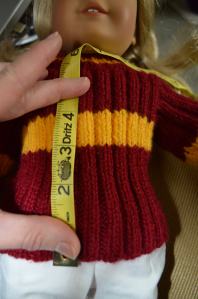





 I’m not going to lie, I think the easier option is the way to go. If you follow the general directions with the pattern (piece #21), you can make knee pads that look like this picture.
I’m not going to lie, I think the easier option is the way to go. If you follow the general directions with the pattern (piece #21), you can make knee pads that look like this picture.







